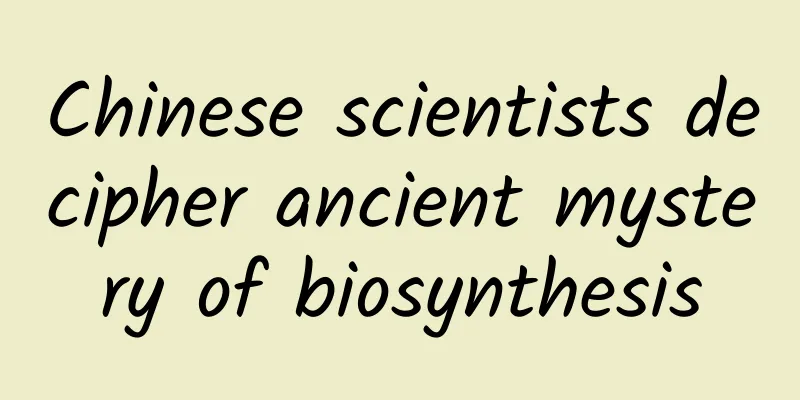Chinese scientists decipher ancient mystery of biosynthesis

|
Chitin biosynthesis is an ancient and conserved synthesis pathway. Map by the Science Visualization Center of China Science News Chitin can be found in everything from trilobites to butterflies, from sea anemones to snails, from yeast to Candida albicans. Chitin, commonly known as chitin, appeared as early as the Cambrian explosion 530 million years ago. It is now widely found in fungi, arthropods, mollusks, annelids, coelenterates and protozoa, but is never synthesized in plants and mammals. Scientists have been trying to unravel the mystery of chitin biosynthesis, an ancient and conservative synthesis pathway. On September 21, the research team led by Professor Yang Qing from the Institute of Plant Protection/Institute of Agricultural Genomics of the Chinese Academy of Agricultural Sciences and Gong Yong, a researcher at the Institute of High Energy Physics of the Chinese Academy of Sciences, published a research result that took fifteen years to complete online in Nature. The study analyzed the cryo-electron microscopy structure of chitin synthase from Phytophthora sojae, revealing for the first time the complete process of chitin biosynthesis and clarifying the mechanism by which nikkomycin inhibits chitin biosynthesis. This is the first paper published in Nature in the field of pesticide research in my country. Qian Xuhong, an academician of the Chinese Academy of Engineering and president of East China Normal University, pointed out that the research has broken through a nearly 50-year development bottleneck in the field of chitin pesticides, and provided a stage for the realization of the dream of eco-friendly pesticides that has not been realized for decades: the precise design of green pesticides based on the structure of chitin synthase. This research result is of milestone significance, marking that China's pesticide research and development level has been raised to the level of original innovation in basic theory. This is also one of the most important basic advances in global pesticide innovation research and development in recent decades. New hope for green pesticides Chitin is a natural biopolymer composed of N-acetylglucosamine. Its biosynthesis is essential for the survival and reproduction of a large number of organisms, including many pests, pathogenic fungi and oomycetes that seriously harm agricultural production. Kang Le, an academician of the Chinese Academy of Sciences and president of Hebei University, said that oomycetes may be the lowest organisms that can synthesize chitin. Chitin synthesis is an extremely ancient and conservative pathway that is essential for the formation and development of the exoskeleton, trachea, digestive tract, etc. formed by the ectoderm of insects and arthropods, and is a source of carbon and nitrogen for many microorganisms. Yang Qing, the corresponding author of the paper, told China Science Daily that chitin is an indispensable structural component in insects and fungi, but does not exist in plants and mammals, so chitin synthase is one of the important targets for creating efficient, safe and eco-friendly pesticides. "Chitin synthase is a target for both fungicides and insecticides," said Yang Qing. Currently, the use of pesticides reduces direct economic losses in my country by about 100 billion yuan each year, but pesticide toxicity and pesticide resistance from pests and diseases have brought severe challenges. Yang Qing said that accelerating the development of safe pesticides with new mechanisms of action is an effective solution. The core of the scientific problem lies in the molecular targets of pesticides, that is, biological macromolecules in pests and diseases that can bind to pesticide molecules to exert their efficacy, such as proteins, enzymes, peptides and nucleic acids. However, 70% of the widely used insecticides in the world only target five molecular targets, and 60% of the widely used fungicides only target three targets. "There are very few molecular targets," said Chen Wei, the first author of the paper and an associate researcher at the Institute of Plant Protection. Long-term use of pesticides targeting a single target can easily lead to high resistance of pests and diseases, which ultimately leads to frequent outbreaks of pests and diseases due to the inability of pesticides to control pest and disease populations. This is also a major problem facing global agricultural pest and disease control. Song Baoan, academician of the Chinese Academy of Engineering and president of Guizhou University, pointed out that the development and utilization of green pesticide molecular targets has become a major need of the country. A new target can not only give birth to dozens or even hundreds of pesticide varieties, but also greatly alleviate the problem of pesticide resistance of existing pesticide varieties. Since the 1970s, people have developed active small molecule compounds that can inhibit chitin synthesis. These compounds have shown great application and market prospects as fungicides and insecticides. For example, nikkomycin discovered by Bayer in 1976 showed good fungicidal activity against a variety of agricultural pathogens such as Phytophthora solani, Saprolegnia solani, and Aspergillus fumigatus, and has entered Phase II clinical trials as an antifungal drug for human use. In 1978, artificially synthesized benzoylurea compounds can effectively prevent chitin synthesis in insects. Currently, this type of compound pesticide accounts for 3% of the insecticide market, with annual sales reaching US$441 million. However, in the past 50 years, although countries around the world have invested a lot of manpower, material resources and enthusiasm to try to develop more types and more efficient green pesticides targeting chitin synthase, progress has always been slow. "One of the important reasons is the lack of accurate three-dimensional structural information of chitin synthase. The unclear structure-function relationship of chitin synthase has seriously hindered the design of new pesticides for this enzyme." Yang Qing said that the difficulty in studying chitin synthase lies in the fact that it is a membrane protein bound to the cell membrane. For membrane proteins to exist stably in vitro, an environment that can simulate the cell membrane is required, which is difficult to achieve. The molecular mechanism of chitin synthesis revealed for the first time "We have always been clear about the unresolved scientific problems of chitin synthase, so we can go straight to this problem to find the answer when the technology matures." Yang Qing said that the successful analysis of the mystery of chitin synthase benefited from the progress of science and technology, as well as her team's long-term commitment to chitin biology research, and rich accumulation in chitin synthesis, hydrolysis and modification. They selected the chitin synthase PsChs1 of Phytophthora sojae as the research object. Chen Wei introduced that Phytophthora sojae is an oomycete and is the main pathogen that causes soybean root rot, causing more than $1 billion in economic losses worldwide each year. Soybean Phytophthora sojae causes a 10% shortfall in soybean harvest in my country each year. Through cryo-electron microscopy, scanning electron microscopy, X-ray diffraction and other techniques, Yang Qing's team analyzed the three-dimensional structure of chitin synthase in five different states, which respectively represent the enzyme's free state, substrate-bound state, chitin chain-bound state, product-bound state and the state where enzyme activity is inhibited. The three-dimensional structure of chitin synthase. Photo courtesy of the Chinese Academy of Agricultural Sciences Chen Wei said that the discovery of these structures revealed for the first time the working mechanism of chitin synthase: first, chitin synthase transfers the sugar group on the donor substrate to the acceptor chitin sugar chain; then, the newly generated chitin sugar chain is released to the outside of the cell through the "transmembrane transport" channel on the cell membrane; finally, the released chitin chains spontaneously assemble into chitin nanofibers. Mechanism of chitin biosynthesis. Image provided by Chinese Academy of Agricultural Sciences Kang Le pointed out that this study revealed for the first time at the atomic scale a multi-step, directed chitin biosynthesis process catalyzed by chitin synthase, which is a major breakthrough in the field of biology. Further research found that after knocking out the chitin synthase gene of Phytophthora, the life processes of Phytophthora such as mycelial growth, sporangium production and zoospore release were damaged, and the virulence and reproductive capacity of Phytophthora were greatly reduced. Therefore, the chitin synthase of Phytophthora sojae can not only serve as a good fungicide target, but also as a model for chitin synthase research. The team also explored the binding pattern of chitin synthase and the active small molecule inhibitor nikkomycin, explaining the mechanism by which nikkomycin inhibits chitin biosynthesis. Milestone in the precise design of green pesticides "The structural information of chitin synthase and its binding with substrates, products and inhibitors also brings new hope for the rational design of small molecules targeting chitin synthase to control the population size of harmful insects," said Kang Le. Yang Qing emphasized that because the gene sequence similarity of chitin synthase of soybean phytophthora is more than 95% with the world's ten most serious agricultural phytophthora, such as potato phytophthora, oak phytophthora and pepper phytophthora, the three-dimensional structure of chitin synthase of soybean phytophthora provides a template for molecular design of fungicides to control soybean phytophthora and potato late blight, etc. This provides the possibility of creating new control drugs for agricultural pests and solving the problem of drug resistance. Song Baoan pointed out that this is a milestone for Chinese scientists in the field of pesticide molecular target research, making it possible to accurately design green pesticides targeting chitin synthase. It will help to create heavyweight green pesticide varieties, enhance the core competitiveness of my country's pesticide industry and the ability to prevent and control agricultural pests, and ensure my country's food security. Complex of chitin synthase and nikkomycin. Photo courtesy of the Chinese Academy of Agricultural Sciences Yang Qing told China Science Daily that the biosynthesis mechanism of chitin is very conservative, but the chitin synthase structure of different species still varies. "We need to screen the designed small molecules extensively to ensure its safety to beneficial insects." Next, they will conduct in-depth research on the molecular design of chitin synthase inhibitors for important pathogens such as soybean phytophthora and potato phytophthora, as well as major pests such as fall armyworm and Asian migratory locust. They will also conduct field experiments to evaluate the field efficacy and safety of these chitin synthase inhibitors and complete the registration of independently innovated pesticides. "It may take 10 years or even longer from research to production application. This involves the drug approval systems of various countries, especially pesticides. It is necessary to ensure that they are safe for humans, livestock, aquatic life and the environment. A lot of further research needs to be done," said Yang Qing. The Institute of Plant Protection, Chinese Academy of Agricultural Sciences is the first completing unit of the paper. Chen Wei, Professor Cao Peng of Beijing University of Technology and Liu Yuansheng, PhD of Dalian University of Technology are the co-first authors of this paper, and Yang Qing and Gong Yong are the co-corresponding authors. Related paper information: https://doi.org/10.1038/s41586-022-05244-5 Source: China Science Daily https://news.sciencenet.cn/htmlnews/2022/9/486613.shtm |
<<: A chicken that grew 5 kilograms in 42 days, was it injected with hormones?
Recommend
World Earth Day | How many people can the earth support?
As early as 2012, the academic journal Journal of...
Analysis of Internet Financial Product Operation Strategy
The main product model of Internet finance is rel...
collect! Google Ads Terms That Marketers Must Know
The following common Google Ads terms will help y...
Mid-Autumn Festival Special: I want to go home and see ____!
Traveling across the world See the vast world But...
Alien Rubik's Cube Tutorial
Alien Rubik's Cube Tutorial Resource Introduc...
Ningxia College Entrance Examination Score Line 2020 [First and Second Score Line Released] 2020 Ningxia College Entrance Examination Score Line List
Ningxia College Entrance Examination Score Line 2...
The entire process of setting up and optimizing information flow advertising accounts, a must-read for placements!
Too little exposure and no sales? How to set a re...
Daily Fresh product analysis!
On June 13, 2019, MissFresh founder and CEO Xu Zh...
What is the origin of this funniest product that jumped more than 1,200 places in the App Store ranking overnight? !
One day, I was eating quietly in the office when ...
Are there any small satellites with the same name as your hometown? What are the secrets of naming small satellites after places?
In recent years, Jilin-1, Beijing-3 and other sma...
The paradox of assisted driving takeover, how can autonomous driving come to the rescue?
Autonomous driving = no accidents? After NIO'...
What are the methods for selecting products for live streaming sales?
With the development of live streaming e-commerce...
Apple releases iOS 8.1.2 update: Input method bug still exists
On December 10, Apple officially released the iOS...





![New Media Operations Practical Manual Series [Tools] Learning Video Tutorial Training Course](/upload/images/67cc4ea240853.webp)



